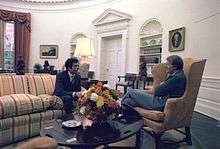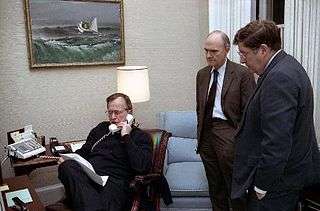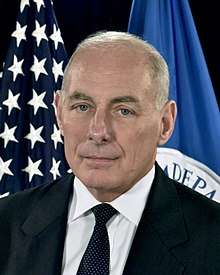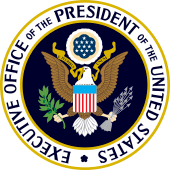White House Chief of Staff
| White House Chief of Staff | |
|---|---|
 | |
|
Executive Office of the President White House Office | |
| Reports to | The President of the United States |
| Appointer | The President of the United States |
| Formation |
1946 (Assistant to the President) 1961 (White House Chief of Staff) |
| First holder | John R. Steelman |
| Website | The White House |
The White House Chief of Staff has traditionally been the highest-ranking non-elected employee of the White House. The Chief of Staff position is the successor to the earlier role of the President's private secretary. The role was formalized as the Assistant to the President in 1946 and acquired its current title in 1961. The current official title is Assistant to the President and Chief of Staff.
The Chief of Staff is a political appointee of the President who does not require Senate confirmation, and who serves at the pleasure of the President. The position is considered to be a stepping stone. Although not a legal requirement, each incoming President appoints their chief of staff.
In the administration of Donald Trump, the current Chief of Staff is John F. Kelly, who succeeded Reince Priebus on July 31, 2017.[1]
History
The duties of the White House chief of staff vary greatly from one administration to another and, in fact, there is no legal requirement that the president even fill the position. However, since at least 1979, all presidents have found the need for a chief of staff, who typically oversees the actions of the White House staff, manages the president's schedule, and decides who is allowed to meet with the president. Because of these duties, the chief of staff has at various times been labeled "The Gatekeeper", or "the power behind the throne".
Originally, the duties now performed by the chief of staff belonged to the president's private secretary and were fulfilled by crucial confidants and advisers such as George B. Cortelyou, Joseph Tumulty, and Louis McHenry Howe to Presidents Theodore Roosevelt, Woodrow Wilson, and Franklin Roosevelt, respectively.[2] The private secretary served as the president's de facto chief aide in a role that combined personal and professional assignments of highly delicate and demanding natures, requiring great skill and discretion.[3] The job of gatekeeper and overseeing the president's schedule was separately delegated to the appointments secretary, as with FDR's aide Edwin "Pa" Watson.
From 1933 to 1939, as he greatly expanded the scope of the federal government's policies and powers in response to the Great Depression, Roosevelt relied on his "Brain Trust" of top advisers. Although working directly for the president, they were often appointed to vacant positions in agencies and departments, whence they drew their salaries since the White House lacked statutory or budgetary authority to create new staff positions. It was not until 1939, during Franklin D. Roosevelt's second term in office, that the foundations of the modern White House staff were created using a formal structure. Roosevelt was able to get Congress to approve the creation of the Executive Office of the President, which would report directly to the president. During World War II, Roosevelt created the position of "Chief of Staff to the Commander in Chief" for his principal military adviser, Fleet Admiral William D. Leahy.
In 1946, in response to the rapid growth of the U.S. government's executive branch, the position of "Assistant to the President of the United States" was established. Charged with the affairs of the White House, it was the immediate predecessor to the modern chief of staff. It was in 1953, under Republican President Dwight D. Eisenhower, that the president's preeminent assistant was designated the "White House Chief of Staff".
Assistant to the president became a rank generally shared by the chief of staff with such senior aides as deputy chiefs of staff, the White House counsel, the White House press secretary, and others. This new system did not catch on immediately. Democrats Kennedy and Johnson still relied on their appointments secretaries instead, and it was not until the Nixon administration that the chief of staff took over maintenance of the President's schedule. This concentration of power in the Nixon and Ford White House (whose last chief of staff was Dick Cheney) led presidential candidate Jimmy Carter to campaign in 1976 with the promise that he would not appoint a chief of staff. And indeed, for the first two and a half years of his presidency, he appointed no one to the post.[4][5]
The average tenure for a White House chief of staff is a little more than 18 months.[6] The inaugural chief of staff, John R. Steelman, under Harry S. Truman, was also the last to be a president's only chief of staff, not counting Kenneth O'Donnell during John F. Kennedy's 34 months in office. (Andrew Card and Denis McDonough each served at least one entire presidential term of office under Presidents George W. Bush and Barack Obama, respectively). Steelman also holds the record for longest-serving chief of staff (six years).
Most White House chiefs of staff are former politicians, and many continue their political careers in other senior roles. Lyndon Johnson's chief of staff W. Marvin Watson became the Postmaster General later in LBJ's term. Richard Nixon's Chief of Staff Alexander Haig, a career U.S. Army officer with his capstone military position being CINCUSEUCOM/SACEUR, later became Secretary of State under Ronald Reagan. Cheney later became a Congressman for Wyoming, Secretary of Defense under George H. W. Bush and vice president in the George W. Bush administration. Donald Rumsfeld was another chief of staff for Ford and subsequently served as Secretary of Defense both in the Ford administration and decades later, also in the George W. Bush administration. Rahm Emanuel left the House of Representatives to become Barack Obama's chief of staff and subsequently became Mayor of Chicago. Jack Lew, President Obama's fourth chief of staff, was later appointed Secretary of the Treasury.
Role



Chris Whipple, author of The Gatekeepers: How the White House Chiefs of Staff Define Every Presidency, loosely describes the role of a White House chief of staff through his interview with former President Barack Obama: "During the last days of his presidency, Barack Obama observed: 'One of the things I've learned is that the big breakthroughs are typically the result of a lot of grunt work—just a whole lot of blocking and tackling.' Grunt work is what chiefs of staff do."[6]
The responsibilities of the chief of staff are both managerial and advisory and can include the following:
- Select key White House staff and supervise them;
- Structure the White House staff system;
- Control the flow of people into the Oval Office;
- Manage the flow of information;
- Protect the interests of the president;
- Negotiate with Congress, other members of the executive branch, and extra-governmental political groups to implement the president's agenda; and
- Advise the president on various issues, including telling the president what they do not want to hear.[6]
These responsibilities extend to firing of staff members: in the case of Omarosa Manigault Newman, who published a tape she said was made in the Situation Room of her firing by Chief of Staff John Kelly, the Chief of Staff said that his decision for her departure was non-negotiable and that "the staff and everyone on the staff works for me and not the president."[7]
Richard Nixon's first chief of staff, H. R. Haldeman, garnered a reputation in Washington for the iron hand he wielded in the position—famously referring to himself as "the president's son-of-a-bitch", he was a rigid gatekeeper who would frequently meet with administration officials in place of the president, then report himself to Nixon on the officials' talking points. Journalist Bob Woodward, in his books All the President's Men and The Secret Man, wrote that many of his sources, including the famous Deep Throat, displayed a genuine fear of Haldeman.[8][9]
In popular culture
- In the 1993 film Dave, Frank Langella plays White House Chief of Staff Bob Alexander.
- In the NBC television drama The West Wing (1999–2006), the role of White House Chief of Staff was held by Leo McGarry (John Spencer), and later by C. J. Cregg (Allison Janney) in the Bartlet Administration and by Josh Lyman (Bradley Whitford) in the Santos Administration.
- In the 1995 movie The American President, White House Chief of Staff A. J. McInerney in the Shepherd Administration was played by Martin Sheen, who later went on to play President Jed Bartlet in The West Wing, created and largely written by The American President screenwriter Aaron Sorkin.
- Jeff Perry portrayed White House Chief of Staff Cyrus Beene in the ABC drama Scandal. Portia de Rossi portrayed White House Chief of Staff Elizabeth North in the same series following the firing of Cyrus Beene by President Grant in the Season 4 finale. Darby Stanchfield portrays Abby Whelan, President Fitzgerald Grant's chief of staff until the end of his presidency after being asked to fire Cyrus. Kerry Washington stars in the series as Olivia Pope, and now acts as Mellie Grant's current chief of staff.
- In House of Cards, Michael Kelly portrays Underwood's presidential chief of staff, Doug Stamper, who was also his vice presidential chief of staff. Sakina Jaffrey portrayed previous President Garrett Walker's Chief of Staff, Linda Vasquez.
- In the HBO television comedy Veep, Kevin Dunn plays the role of the White House Chief of Staff Ben Cafferty. Anna Chlumsky portrays Selina Meyer's vice presidential chief of staff.
- In the Fox television series 24, several people have played the role of White House Chief of Staff: Jude Ciccolella as Mike Novick, D. B. Woodside as Wayne Palmer, John Allen Nelson as Walt Cummings, Peter MacNicol as Tom Lennox, Bob Gunton as Ethan Kanin, Sprague Grayden as Olivia Taylor, Chris Diamantopoulos as Rob Weiss, and most recently Tate Donovan as Mark Boudreau in 24: Live Another Day.
- In the CBS television series Madam Secretary, the White House Chief of Staff, Russell Jackson, is played by Željko Ivanek.
- In the ABC television series Designated Survivor, Adan Canto plays White House Chief of Staff Aaron Shore, who assumes the position of chief of staff under newly sworn in President Tom Kirkman, who ascends from his former position of Secretary of Housing and Urban Development, after President Richmond, the vice president and cabinet are killed during a terrorist attack at the State of the Union address. Shore is later replaced by Emily Rhodes (Italia Ricci) as Chief of Staff and subsequently becomes National Security Advisor.
- In Tom Clancy's Ryanverse, Arnie Van Damm is White House Chief of Staff to three presidents, Fowler, Durling and Ryan.
See also
References
- ↑ "Trump names Gen. John Kelly as chief of staff, Priebus out". Politico. Retrieved 28 July 2017.
- ↑ "New Quarters". Time. 1934-12-17. Retrieved 2008-05-08.
- ↑ "An Appointment". Time. 1923-08-20. Retrieved 2009-05-09.
- ↑ "Hamilton Jordan, Carter's Right Hand, Dies at 63". The New York Times. 21 May 2008. Retrieved 7 March 2016.
- ↑ "The Presidency and the Political System". Retrieved 7 March 2016.
- 1 2 3 Whipple, Chris. (2017). The Gatekeepers: How the White House Chiefs of Staff Define Every Presidency. New York: Crown Publishing Group.
- ↑ "Transcript". CNN. August 13, 2018.
- ↑ Woodward, Bob; Bernstein, Carl. (1974) All the President's Men. New York: Simon & Schuster. ISBN 978-0-671-21781-5
- ↑ Woodward, Bob. (2005). The Secret Man. New York: Simon & Schuster. ISBN 0-7432-8715-0

